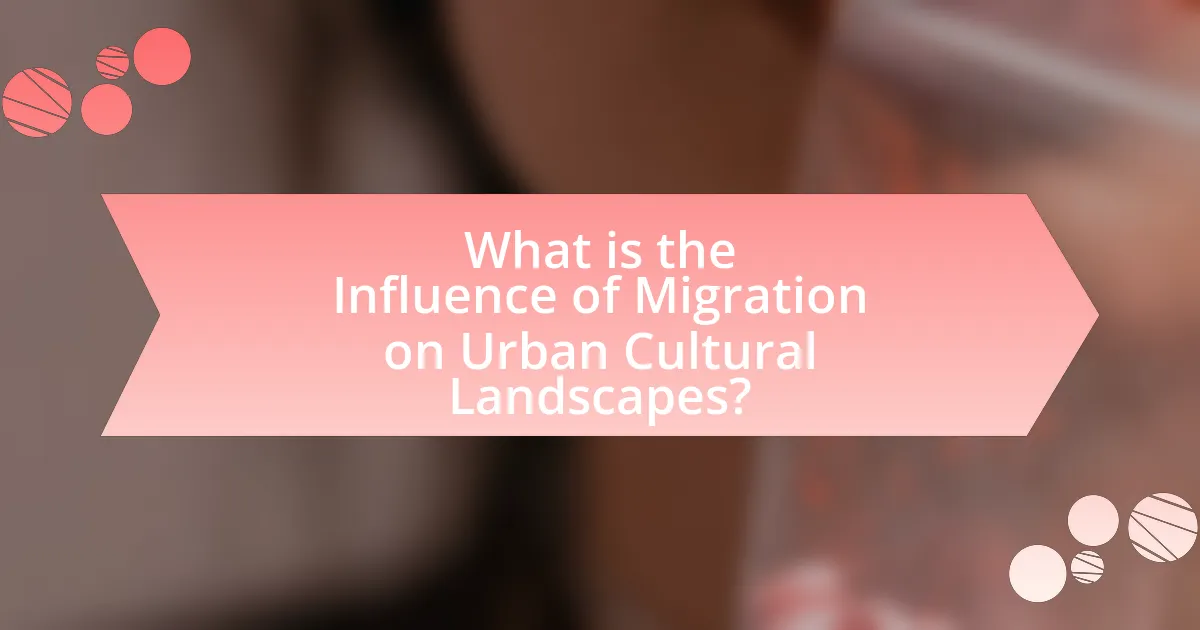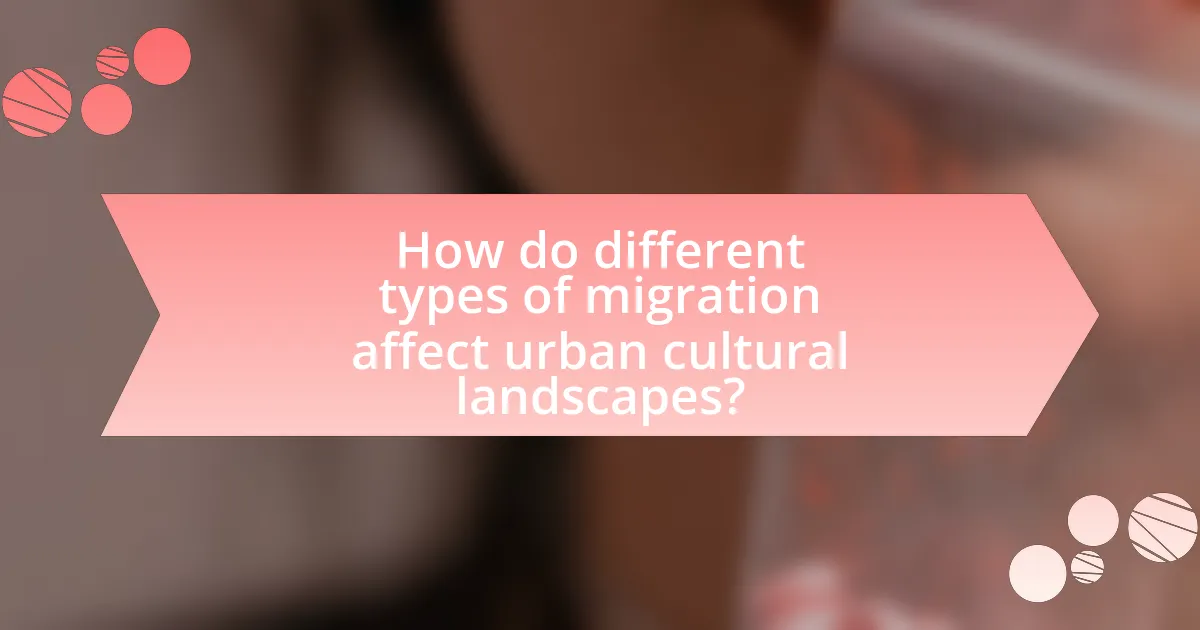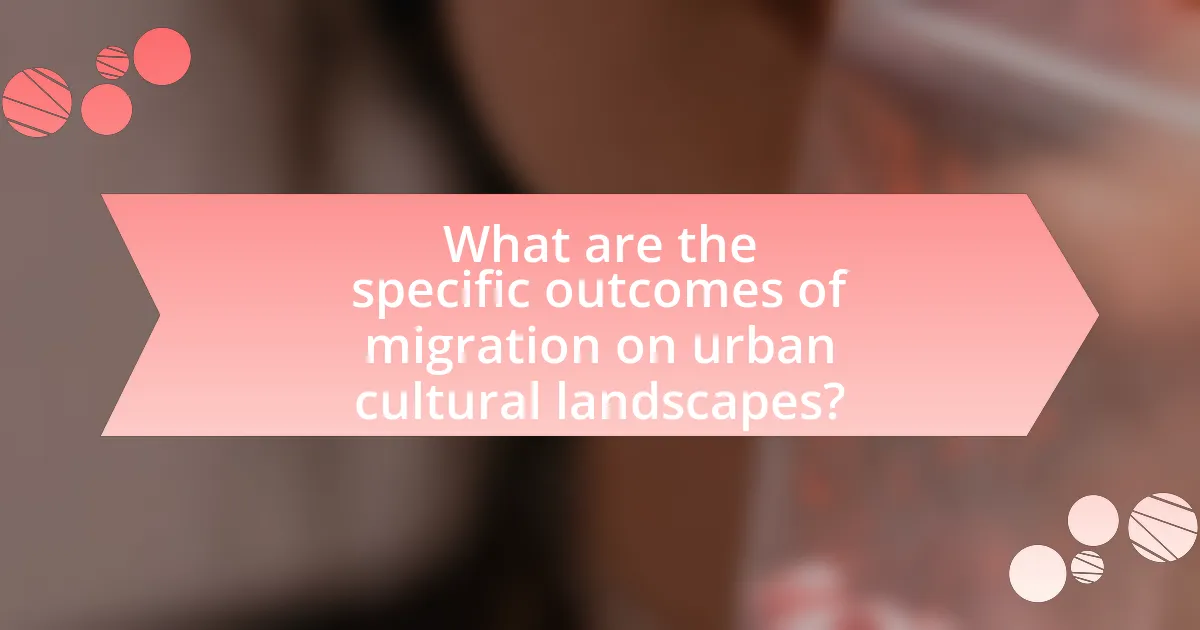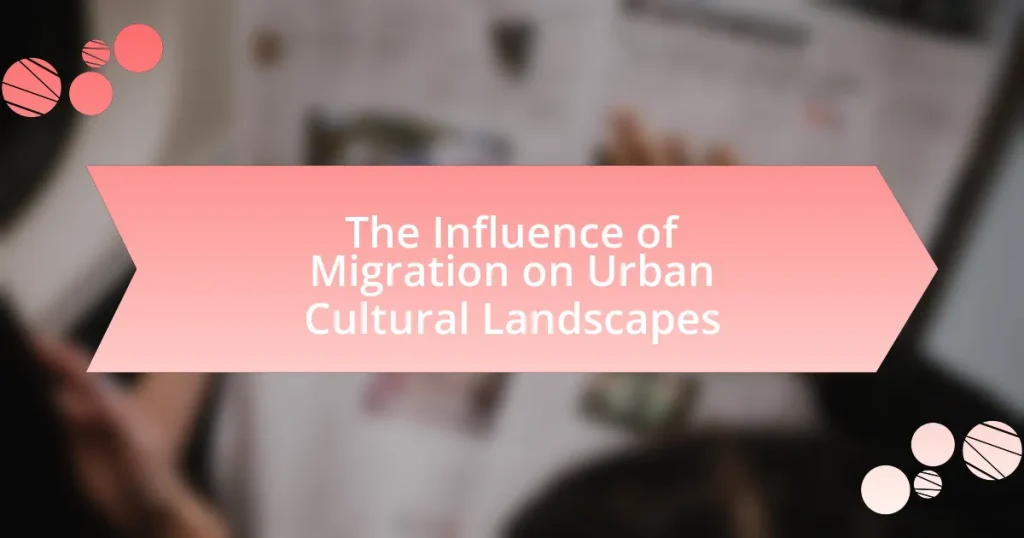Migration plays a crucial role in shaping urban cultural landscapes by introducing diverse cultural practices, languages, and traditions that transform the social fabric of cities. This article explores how migration influences cultural identity, key cultural elements, and local traditions, highlighting the economic impacts and challenges that arise from increased cultural diversity. It examines the distinctions between voluntary and forced migration, the effects of temporary migrations, and the role of policy in managing cultural integration. Additionally, the article discusses the architectural and public space changes resulting from migration, as well as the contributions of migrant-owned businesses to local economies. Overall, it emphasizes the importance of understanding migration’s impact on urban environments for effective urban governance and sustainable development.

What is the Influence of Migration on Urban Cultural Landscapes?
Migration significantly influences urban cultural landscapes by introducing diverse cultural practices, languages, and traditions, which reshape the social fabric of cities. This transformation is evident in the emergence of multicultural neighborhoods, where various ethnic communities contribute to local cuisine, festivals, and art forms, enhancing the cultural richness of urban areas. For instance, cities like New York and London showcase vibrant cultural diversity, with immigrant populations influencing everything from street food to public art installations. Studies indicate that urban areas with high levels of migration often experience increased cultural exchange and innovation, leading to dynamic urban environments that reflect a blend of global influences.
How does migration shape the cultural identity of urban areas?
Migration significantly shapes the cultural identity of urban areas by introducing diverse cultural practices, languages, and traditions. This influx of different communities leads to a blending of cultural elements, which can be observed in various aspects such as cuisine, festivals, and art. For instance, cities like New York and London showcase a rich tapestry of cultural influences due to their historical roles as migration hubs, where over 36% of New York’s population is foreign-born, contributing to its multicultural identity. Additionally, urban areas often develop neighborhoods that reflect the heritage of immigrant groups, such as Little Italy or Chinatown, which serve as cultural enclaves that preserve and promote their unique identities while also enriching the broader urban culture.
What are the key cultural elements affected by migration?
The key cultural elements affected by migration include language, traditions, cuisine, and social practices. Migration introduces new languages to urban areas, often leading to bilingualism or multilingualism, as seen in cities like Toronto, where over 160 languages are spoken. Additionally, migration brings diverse traditions and festivals, enriching local cultural calendars; for instance, the celebration of Diwali in London showcases Indian cultural influence. Cuisine is significantly transformed as migrants introduce their culinary practices, contributing to the multicultural food scene in cities like New York, where food from various cultures coexists. Lastly, social practices, including family structures and community engagement, evolve as migrants integrate into new environments, impacting social dynamics and community cohesion.
How do migrant communities contribute to local traditions?
Migrant communities contribute to local traditions by introducing new cultural practices, cuisines, and festivals that enrich the existing cultural landscape. For instance, the celebration of Diwali in cities like London and New York showcases how Indian migrants have integrated their traditions into the local context, influencing public celebrations and community events. Additionally, research by the Pew Research Center indicates that immigrant populations often maintain their cultural heritage while simultaneously adopting elements of the host culture, leading to a dynamic exchange that revitalizes local traditions. This blending of cultures not only fosters diversity but also enhances social cohesion within urban environments.
Why is understanding migration’s impact on urban landscapes important?
Understanding migration’s impact on urban landscapes is important because it shapes the social, economic, and physical characteristics of cities. Migration contributes to demographic changes, influencing urban planning, housing demand, and public services. For instance, according to the United Nations, by 2050, 68% of the global population is projected to live in urban areas, with migration being a key driver of this trend. This demographic shift necessitates adaptive urban policies to accommodate diverse populations and promote social cohesion. Additionally, migration can lead to cultural enrichment, as seen in cities like New York and London, where immigrant communities contribute to vibrant cultural landscapes and economic growth. Understanding these dynamics is crucial for effective urban governance and sustainable development.
What are the social implications of migration on urban culture?
Migration significantly alters urban culture by introducing diverse cultural practices, languages, and social norms. This influx of varied backgrounds fosters multiculturalism, which can enhance creativity and innovation within urban environments. For instance, cities like New York and London have thrived culturally due to their immigrant populations, leading to a rich tapestry of food, art, and traditions that reflect global influences. Additionally, migration can lead to social tensions, as differing cultural values may clash, resulting in challenges related to integration and community cohesion. Studies, such as those by the Pew Research Center, indicate that urban areas with higher migration rates often experience both cultural enrichment and social friction, highlighting the dual nature of migration’s impact on urban culture.
How does migration influence urban planning and development?
Migration significantly influences urban planning and development by altering demographic patterns and increasing demand for housing, infrastructure, and services. As populations shift due to migration, urban planners must adapt to the changing needs of diverse communities, which often leads to the development of new residential areas, transportation systems, and public amenities. For instance, cities experiencing high levels of immigration may see a rise in multicultural neighborhoods, necessitating the incorporation of culturally relevant services and facilities. According to the United Nations, by 2050, 68% of the world’s population is projected to live in urban areas, highlighting the urgency for urban planners to address the challenges and opportunities presented by migration.
What challenges arise from migration in urban cultural contexts?
Migration in urban cultural contexts presents challenges such as cultural integration, social cohesion, and resource allocation. Cultural integration issues arise when diverse groups struggle to coexist, leading to tensions and misunderstandings. Social cohesion can be affected as established communities may resist newcomers, resulting in segregation or conflict. Resource allocation challenges occur when cities face increased demand for housing, education, and healthcare, often outpacing available services. For instance, a study by the United Nations in 2020 highlighted that cities experiencing high migration rates often report increased pressure on public services, exacerbating existing inequalities.
How do conflicts between different cultural groups manifest in cities?
Conflicts between different cultural groups in cities manifest through social tensions, economic disparities, and political disagreements. These conflicts often arise from competition for resources, such as housing and jobs, leading to segregation and social unrest. For example, in cities like Paris and London, tensions have escalated between immigrant communities and local populations, resulting in protests and riots, as seen during the 2005 civil unrest in France, which highlighted the frustrations of marginalized immigrant groups. Additionally, cultural misunderstandings can lead to clashes over public space usage, as evidenced by disputes over religious symbols or practices in urban areas, further exacerbating divisions.
What role does policy play in managing cultural diversity in urban areas?
Policy plays a crucial role in managing cultural diversity in urban areas by establishing frameworks that promote inclusion, equity, and social cohesion among diverse populations. Effective policies can facilitate access to resources, services, and opportunities for various cultural groups, thereby reducing tensions and fostering mutual respect. For instance, cities like Toronto have implemented multicultural policies that support community engagement and representation, which have been shown to enhance social integration and economic participation among immigrant populations. Additionally, research from the Migration Policy Institute indicates that inclusive urban policies can lead to improved quality of life and community resilience, demonstrating the significant impact of policy on managing cultural diversity in urban settings.

How do different types of migration affect urban cultural landscapes?
Different types of migration significantly reshape urban cultural landscapes by introducing diverse cultural practices, languages, and social norms. For instance, international migration often leads to the establishment of ethnic enclaves, which can transform neighborhoods through the proliferation of cultural businesses, festivals, and community organizations that reflect the migrants’ heritage. According to the Pew Research Center, cities with high levels of immigration, such as Los Angeles and New York, exhibit distinct cultural identities influenced by their immigrant populations, showcasing a blend of cuisines, art forms, and traditions. Additionally, rural-to-urban migration contributes to urbanization, leading to demographic shifts that can alter local cultural dynamics, as seen in cities like Beijing, where internal migration has resulted in a mix of rural and urban cultural elements. These changes not only enrich the urban fabric but also challenge existing cultural norms, fostering both conflict and collaboration among diverse groups.
What are the distinctions between voluntary and forced migration?
Voluntary migration occurs when individuals choose to relocate based on personal desires, such as seeking better economic opportunities or improved living conditions. In contrast, forced migration happens when individuals are compelled to leave their homes due to external pressures, such as conflict, persecution, or natural disasters. For example, the United Nations High Commissioner for Refugees reported that in 2021, there were over 26 million refugees worldwide, indicating a significant number of people experiencing forced migration due to violence and instability. This distinction highlights the differing motivations and circumstances surrounding each type of migration, impacting urban cultural landscapes in unique ways.
How does voluntary migration contribute to urban cultural enrichment?
Voluntary migration contributes to urban cultural enrichment by introducing diverse cultural practices, languages, and traditions into urban environments. This influx of new cultural elements enhances the social fabric of cities, fostering creativity and innovation. For instance, cities like New York and London have seen significant cultural contributions from immigrant communities, which have led to the establishment of vibrant neighborhoods, culinary diversity, and artistic expressions. Research by the Migration Policy Institute indicates that immigrants are responsible for a substantial portion of cultural production in urban areas, including music, art, and cuisine, thereby enriching the overall cultural landscape.
What challenges do forced migrants face in adapting to urban cultures?
Forced migrants face significant challenges in adapting to urban cultures, primarily due to language barriers, social isolation, and economic instability. Language barriers hinder effective communication and access to services, making it difficult for forced migrants to integrate into the local community. Social isolation often results from a lack of established networks and support systems, which can exacerbate feelings of alienation. Economic instability, characterized by limited job opportunities and discrimination in the labor market, further complicates their ability to establish a stable life in urban settings. According to the United Nations High Commissioner for Refugees (UNHCR), over 70 million people are forcibly displaced worldwide, highlighting the widespread nature of these challenges.
How does international migration differ from internal migration in urban settings?
International migration differs from internal migration in urban settings primarily in terms of the origin of migrants and the cultural impacts they bring. International migrants relocate from one country to another, often introducing diverse cultural practices, languages, and traditions that can significantly alter the urban cultural landscape. For example, cities like Toronto and London have seen substantial changes in their cultural dynamics due to the influx of international migrants, leading to multicultural neighborhoods and varied culinary scenes. In contrast, internal migration involves movement within the same country, typically resulting in demographic shifts without the same level of cultural diversity, as migrants often share a common national identity. This distinction highlights how international migration can enrich urban environments through cultural exchange, while internal migration tends to reinforce existing cultural norms.
What unique cultural influences do international migrants bring to cities?
International migrants bring diverse cultural influences to cities, including culinary traditions, artistic expressions, and social practices. These influences enrich urban environments by introducing new cuisines, such as the popularity of Thai food in cities like Los Angeles, which reflects the significant Thai immigrant community. Additionally, migrants contribute to the arts through music, dance, and festivals, exemplified by the vibrant Caribbean Carnival in London, showcasing the cultural heritage of Caribbean migrants. Social practices, such as communal celebrations and religious observances, foster multicultural interactions and enhance social cohesion within urban settings. These cultural contributions not only diversify the local culture but also stimulate economic growth through tourism and local businesses.
How does internal migration reshape local cultural dynamics?
Internal migration reshapes local cultural dynamics by introducing diverse cultural practices, languages, and social norms into communities. This influx of new residents often leads to the blending of traditions, resulting in a more multicultural environment. For instance, cities like Los Angeles and New York have experienced significant internal migration, which has enriched their cultural landscapes through festivals, culinary diversity, and artistic expressions that reflect the backgrounds of various migrant groups. Research indicates that areas with high internal migration rates often see increased cultural events and community engagement, fostering a sense of shared identity while also highlighting distinct cultural heritages.
What role do temporary migrations play in urban cultural landscapes?
Temporary migrations significantly enrich urban cultural landscapes by introducing diverse cultural practices, languages, and social dynamics. These migrations often lead to the establishment of multicultural neighborhoods, where various traditions and cuisines coexist, enhancing the city’s cultural fabric. For instance, cities like Toronto and London have seen their cultural landscapes transformed by temporary migrants, who contribute to local economies and cultural events, thereby fostering a vibrant, dynamic urban identity. Research indicates that such migrations can lead to increased cultural exchange and innovation, as seen in the rise of multicultural festivals and community initiatives that celebrate diversity.
How do seasonal workers impact local cultural practices?
Seasonal workers significantly influence local cultural practices by introducing new customs, traditions, and perspectives that enrich the community’s cultural landscape. Their presence often leads to the blending of cultural elements, as seasonal workers share their unique backgrounds through festivals, cuisine, and art, which can enhance local cultural events. For instance, in agricultural regions, the influx of seasonal laborers during harvest time can result in the incorporation of diverse culinary traditions into local food festivals, fostering cultural exchange. Studies have shown that communities with high seasonal worker populations often experience a revitalization of cultural practices, as seen in regions like the Napa Valley, where the interaction between local residents and seasonal vineyard workers has led to a fusion of cultural celebrations and culinary innovations.
What are the long-term effects of temporary migration on urban identity?
The long-term effects of temporary migration on urban identity include the diversification of cultural practices, shifts in social dynamics, and the redefinition of community belonging. Temporary migrants often introduce new cultural elements, such as cuisine, festivals, and languages, which can enrich the urban cultural landscape and foster multiculturalism. For instance, cities like Toronto and London have seen significant transformations in their urban identities due to the influx of temporary migrants, leading to vibrant neighborhoods that reflect a blend of global cultures. Additionally, social dynamics may shift as temporary migrants interact with local populations, potentially leading to both integration and tension, which can reshape community identities over time. Research indicates that these interactions can result in a more complex urban identity that incorporates both local and migrant influences, ultimately contributing to the evolution of the city’s cultural fabric.

What are the specific outcomes of migration on urban cultural landscapes?
Migration significantly alters urban cultural landscapes by introducing diverse cultural practices, languages, and social dynamics. This influx of new populations often leads to the creation of multicultural neighborhoods, where various ethnic communities establish their own cultural identities through festivals, cuisine, and art. For instance, cities like Toronto and London showcase vibrant cultural mosaics, reflecting the contributions of immigrant communities. Additionally, migration can result in the revitalization of urban areas, as newcomers often invest in local businesses and cultural institutions, enhancing economic activity and cultural exchange. Studies indicate that cities with high levels of migration experience increased cultural innovation and creativity, as diverse perspectives foster new ideas and artistic expressions.
How does migration influence urban architecture and public spaces?
Migration significantly influences urban architecture and public spaces by introducing diverse cultural elements and altering spatial dynamics. As populations move, cities adapt their architectural styles to reflect the new demographics, often resulting in mixed-use developments that cater to various cultural needs. For instance, neighborhoods may feature buildings that incorporate traditional designs from immigrant communities, enhancing cultural representation. Additionally, public spaces are transformed to accommodate multicultural activities, such as markets and festivals, which promote social interaction among diverse groups. Research indicates that cities with high migration rates, like Toronto and London, showcase a blend of architectural styles and vibrant public spaces that reflect their multicultural populations, thereby enriching the urban cultural landscape.
What architectural styles emerge from diverse migrant communities?
Diverse migrant communities give rise to various architectural styles, including but not limited to, Colonial Revival, Art Deco, and Modernist influences. These styles often reflect the cultural heritage and traditions of the migrants, integrating elements from their countries of origin with local architectural practices. For instance, the Colonial Revival style, prominent in the United States, showcases adaptations of European architectural forms, while Art Deco, which emerged in the 1920s, incorporates geometric shapes and vibrant colors influenced by immigrant artisans. Additionally, Modernist architecture, characterized by minimalism and functionalism, has been shaped by the contributions of migrant architects who brought new perspectives and techniques to urban design. This blending of styles illustrates how migration enriches urban landscapes, creating a tapestry of cultural expression in architecture.
How do public spaces reflect the cultural diversity of urban populations?
Public spaces reflect the cultural diversity of urban populations by serving as venues for various cultural expressions, activities, and interactions among different ethnic groups. These spaces often feature multicultural events, festivals, and markets that showcase diverse traditions, cuisines, and art forms, thereby promoting inclusivity and social cohesion. For instance, cities like Toronto and London host annual multicultural festivals in public parks, which attract participants from various backgrounds, highlighting the rich tapestry of cultural identities within the urban environment. Additionally, the design and use of public spaces, such as community gardens or cultural centers, often incorporate elements from different cultures, further illustrating the influence of migration on urban landscapes.
What economic impacts does migration have on urban cultural landscapes?
Migration significantly influences urban cultural landscapes by driving economic growth and diversification. The influx of migrants often leads to increased demand for goods and services, stimulating local economies. For instance, cities with high migration rates, such as New York and London, have seen substantial contributions to their GDP from migrant-owned businesses, which account for a significant percentage of local employment. Additionally, migrants introduce new cultural practices and cuisines, enhancing the urban cultural fabric and attracting tourism, which further boosts economic activity. Studies indicate that areas with diverse populations experience higher levels of innovation and entrepreneurship, as seen in the tech hubs of Silicon Valley, where immigrant entrepreneurs have played a crucial role in the region’s economic success.
How do migrant-owned businesses contribute to local economies?
Migrant-owned businesses significantly contribute to local economies by creating jobs, fostering innovation, and enhancing cultural diversity. These enterprises often fill gaps in the market, providing goods and services that may not be available otherwise. For instance, a study by the Fiscal Policy Institute found that immigrant entrepreneurs are responsible for 28% of all new businesses in the United States, which translates to millions of jobs created. Additionally, migrant-owned businesses often stimulate local economies by generating tax revenue and increasing consumer spending within their communities. This economic activity not only supports local infrastructure but also promotes cultural exchange, enriching the urban landscape.
What is the relationship between cultural festivals and economic growth in urban areas?
Cultural festivals significantly contribute to economic growth in urban areas by attracting tourism, generating revenue, and creating jobs. These events stimulate local economies through increased spending on accommodations, food, and entertainment. For instance, a study by the National Endowment for the Arts found that cultural festivals can boost local economies by millions of dollars, with events like the New Orleans Jazz & Heritage Festival generating approximately $300 million annually. Additionally, cultural festivals enhance community engagement and promote local businesses, further driving economic development.
What strategies can cities adopt to enhance cultural integration through migration?
Cities can enhance cultural integration through migration by implementing inclusive policies that promote social cohesion and community engagement. These strategies include establishing multicultural centers that provide resources and support for migrants, facilitating language and cultural exchange programs, and promoting diverse representation in local governance. For instance, cities like Toronto have successfully utilized community-based initiatives to foster interaction between migrants and local residents, resulting in increased understanding and collaboration. Additionally, research from the Migration Policy Institute indicates that cities that invest in integration programs see improved economic outcomes and social stability, reinforcing the effectiveness of these strategies.
How can community programs foster cultural exchange among migrants and locals?
Community programs can foster cultural exchange among migrants and locals by creating inclusive spaces for interaction and collaboration. These programs often organize events such as cultural festivals, workshops, and language classes that encourage participation from both groups, facilitating mutual understanding and appreciation of diverse traditions. For instance, research by the Migration Policy Institute indicates that community engagement initiatives can significantly enhance social cohesion and reduce cultural barriers, leading to stronger relationships between migrants and local residents. By promoting shared experiences and dialogue, community programs effectively bridge cultural gaps and enrich the urban cultural landscape.
What best practices exist for promoting inclusivity in urban cultural policies?
Best practices for promoting inclusivity in urban cultural policies include engaging diverse community stakeholders in the decision-making process, ensuring representation of marginalized groups in cultural programming, and implementing policies that support equitable access to cultural resources. Engaging stakeholders fosters a sense of ownership and ensures that cultural policies reflect the needs and values of all community members. Representation in programming allows for a broader range of cultural expressions and narratives, which can enhance social cohesion. Policies that promote equitable access, such as funding for community-led initiatives and support for cultural institutions serving diverse populations, help to dismantle barriers that marginalized groups face in participating in cultural life. These practices are supported by research indicating that inclusive cultural policies lead to stronger community ties and improved social outcomes.
